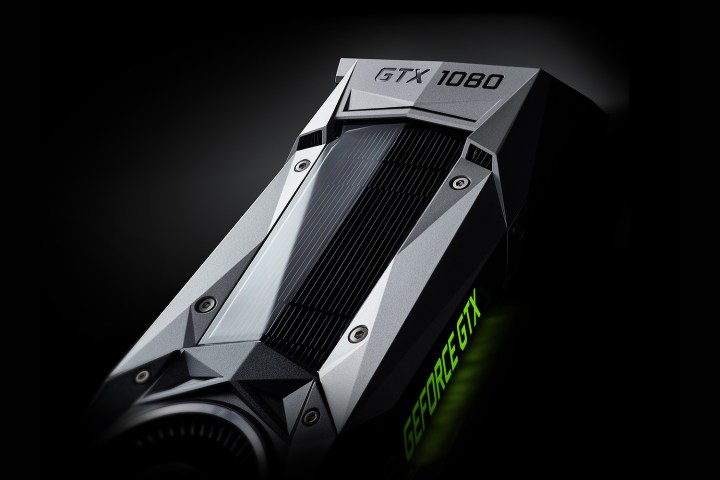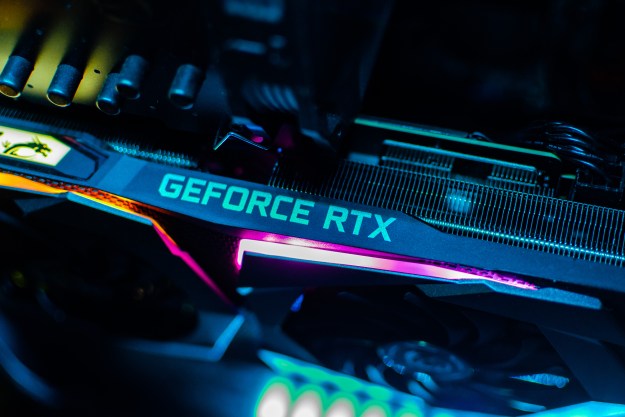
It will reportedly arrive in the form of a GeForce GTX 1080 Ti model, and spec-wise will fit between the GTX Titan X and the GTX 1080. However, like the GTX Titan X, the 1080 Ti will supposedly have a 250-watt power requirement, which is higher than the current vanilla GTX 1080 card on the market.
The “leaked” specs arrive by way of an Overclock3D forum member. According to the report, the card will be based on Nvidia’s GP102 GPU core design, the same design used on the updated GTX Titan X. However, the GTX 1080 Ti will reportedly only use the slower GDDR5 video memory that’s installed on the GTX 1070 and GTX 1060. That slower memory means the 1080 Ti’s memory bandwidth will be slower than the Titan X, but it will still be higher than the GTX 1080.
Nvidia launched the updated Titan X card in July for a crazy $1,200. The company actually just introduced a $200 3GB model of its GTX 1060 in early August to compete with AMD’s low-cost Radeon RX 480 card, which followed the launch of the $250 6GB model in early July. The original GTX 1080 hit the scene in late May for $600 followed by the GTX 1070 in June for $379.
Out of the original three, the GTX 1060 is the slowest, packing 1,280 CUDA cores, a base clock speed of 1,506MHz, and a boost clock speed of 1,708MHz. The GTX 1070 is a step up with 1,920 CUDA cores and clock speeds of 1,506MHz and 1,683MHz. The GTX 1080 is the powerhouse of the three, packed with 2,560 CUDA cores and clock speeds of 1,607MHz and 1,733MHz. The supposed “Ti” model will have even more CUDA cores at 3,328, but sport slower clock speeds of 1,503MHz and 1,623MHz.
The unannounced card will reportedly have a max screen resolution of 7,680 x 4,320 @ 60Hz by way of DisplayPort 1.4, HDMI 2.0b, and Dual Link-DVI connectors. The card will be Nvidia SLI ready, and compatible with a PCIe 3.0 slot. Customers will need one 8-pin and one 6-pin power connector like the Titan X, and should have a 600-watt power supply installed to support this card in addition to all the other local hardware.
Since the reported GTX 1080 Ti specs are the result of a alleged leak, view the hardware details with some skepticism. The card is unconfirmed, and the hardware details could change before Nvidia comes clean with its existence. Until then, feel free to drool over the reported specs and compare them with the Titan X and vanilla GTX 1080 card in the table below.
However, for the uninitiated, note that “SM” in the table stands for Streaming Multiprocessors. These are what run Nvidia’s CUDA kernels, and each one is comprised of 64 CUDA cores and four texture units. Overall, a single graphics chip is partitioned into Graphics Processor Clusters that comprise of five SMs each. Memory controllers are also part of the GPU package.
| Titan X | GTX 1080 Ti | GTX 1080 | |
| SM Units | 56 | 52 | 40 |
| Performance | 11 TFLOPS | 10.8 TFLOPS | 9 TFLOPS |
| CUDA Core Count | 3,584 | 3,328 | 2,560 |
| VRAM Type | GDDR5X | GDDR5 | GDDR5X |
| VRAM Amount | 12GB | 12GB | 8GB |
| Memory Bus Size | 384-bit | 384-bit | 256-bit |
| Memory Bandwidth | 480GB/s | 384GB/s | 320GB/s |
| Base Clock Speed | 1,417MHz | 1.503MHz | 1,607MHz |
| Boost Clock Speed | 1,531MHz | 1,623MHz | 1,733MHz |
Editors' Recommendations
- Nvidia RTX 50-series graphics cards: news, release date, price, and more
- Here’s why I’m glad Nvidia might kill its most powerful GPU
- Even Nvidia’s partners don’t believe in the new RTX 4060 Ti
- Here are 5 GPUs you should buy instead of the RTX 4060 Ti
- Nvidia RTX 4060 Ti vs. RTX 4070: comparing Nvidia’s midrange GPUs



